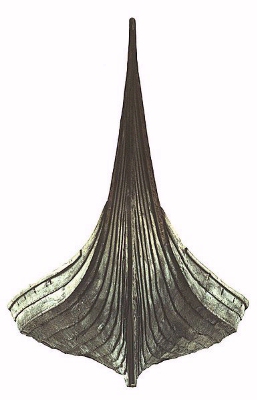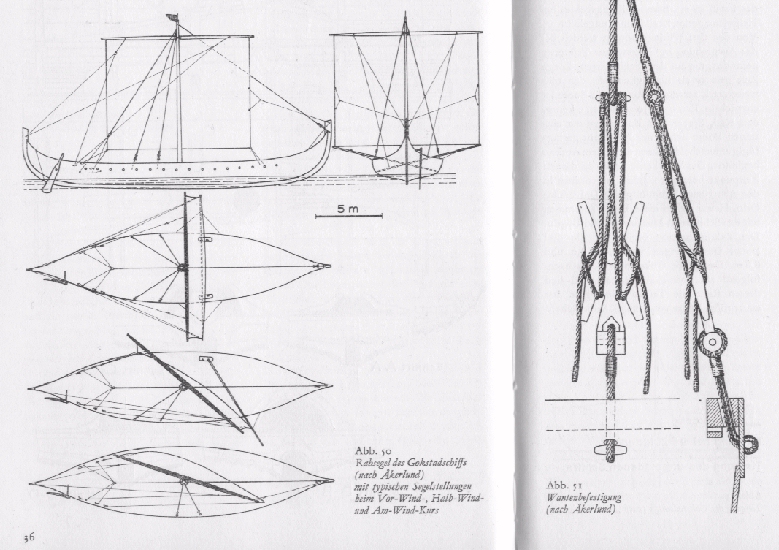
The Oseberg Ship seen from the front, showing the typical shape of the hull (Source: Wiki Commons).
What we today call "Viking Ships" had different names in those times: drakar/drakkar (dragon ship), knorr/knarr/knörr, longship.
Their principle construction was roughly the same, just the size and some details differed.
Viking Ships types were in use at least between 800-1200 in Northern Europe, with emphasis to the period of the "Vikings invasions" 800-1050.
after that period, historic evidence is utterly rare.
The successors to these ship types were the
Hansa Cogs, between 1200 - 1400
|
At least, there are some rare original boats, rediscovered around 1900 - they were used for Viking graves
and lied buried for 1000 years.
The most famous relics are the Drakkar Oseberg and the Gokstad Boat, preserved at
The Viking Ship Museum
in Oslo, Norway.
From these, we know much about the hull and its construction. The rigging of course, did not prevail ...
Then we have some rare depictions, the most famous is
the Bayeux Tapestry in Normandy, France.
OK, we take the Oseberg ship as an example (there is a fine model kit from Heller of it). Its shape is still so good that many details of the hull could
be reconstructed quite easily.
The shape of the viking ships were primarily good for rowing, supported by a sail, just like the Mediterranian galleys.
But in contrary to them, viking ship hulls are very slim, they cut the water almost like modern rowing sport boats, so it is much easier to make speed
by rowing rather than by sailing. What supports this is also the fact that the entire rigging was removable.
The first ships (in Northern Europe) having a fixed mast were the
cogs, 200 years later.
Although many replicas indicate something else, the ancient sail was not taller than 6m, but as wide as 10-12m.
No original masts are fully preserved.
The mast (there was only one) was not fixed in the keel, it was removable (so the entire rigging could be stowed on deck when necessary), e.g. when winds were too strong or too calm,
or when they had to pass under a low bridge.
The rest of the Viking sail is 99% speculation. The mast was too high to stand alone without a minimum of a stay and two backstays.
The square sail must have had at least a halyard, some kind of port and starboard braces and sheets.
From the mere physical point of view, it was obviously possible to swing the yard from +90 to -90 degrees, in other words,
this square sail could be used to sail "large", as well as a for-and-aft sail, and go very closed to the wind, like a schooner.
(Staysails are not "reported"; those came up after 1700, on the Ships of The Line)
Some ancient depictions show a "net sheet" over
the entire foot of the sail. The Bayeux Tapestry shows Vikings in their ships, holding the sail´s foot by hands, not by sheets. But this maybe
a matter of naivity by the artists who made the tapestry...
We can assume that, in order to set or furl the sail (they had only one), the yard was hauled up or veered down to deck.
Topping lifts were not necessary, at least we have no evidence for them.
This is all we know.
|

